Knitting and embroidery go hand in hand, supplementing each other. Practically any vyshivalny seam can be used on knitted cloth. The embroidery can be added to just finished model, and can update once favourite article of clothing which becomes dusty in case for a long time.
Some general councils:
Beginning and finishing embroidery, sew the ends of threads to seamy side of knitted cloth.
At choice of threads for embroidery consider comparability of their thickness to thickness of yarn from which the knitted cloth, composition of fibers and compatibility of flowers is executed.
The tip of needle has to be blunted not to split loop of knitted cloth and not to distort embroidery drawing.
TYPES AND RECEPTIONS OF VYSHIVALNY SEAMS
SEAM FORWARD NEEDLE AND SEAM BACK NEEDLE
These seams are often used for sewing together of details and applied to decoration of products. The edges which are densely laid lengthways, such seams will help to level the twisting cloth connected by front smooth surface.
BUTTONHOLE STITCH (loop on loop)
Otherwise it is called the Swiss darning, is carried out on front smooth surface. Provyazanny loops become covered from above by embroidery according to their drawing. It is ideal seam for knitters who prefer difficult drawings of intarsia, but do not love long vertical lines or separate stitches. The big sites covered with buttonhole stitches will make cloth rigid.
1. Horizontal embroidery along row
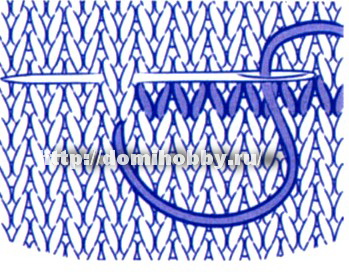
Remove needle through knitted cloth at the loop basis, having left thread of 10 cm on seamy side of work. Pass needle under walls of overlying loop, and then return back it through the loop basis.
Direct it upward once again, to the basis of the following loop. Tightening thread, remember, the stitch has to correspond to density of provyazanny loop.
2. Vertical columns
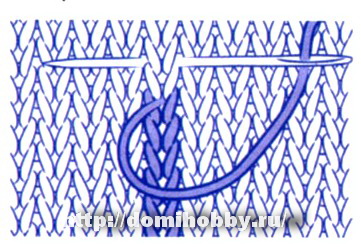
Carry out needle through knitted cloth at the basis of loop and direct it for walls of overlying loop, then return back through the loop basis in front back. Again lift needle to the basis of the following loop up, watching yarn tension. In end of this double stitch the needle has to appear on seamy side. Fix thread, having made stitch over back part of double stitch.
SEAM CROSS
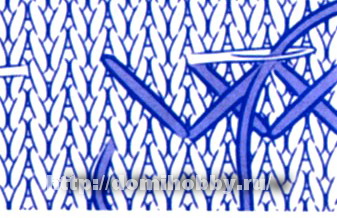
The seam consists of two inclined crossing stitches. It can not form square. But if you want to receive square, carry out cross over two loops and three rows of chulochny smooth surface.
The knitted cloth can be provided lattice from squares or rectangles. Send needle to upper left point of expected seam. Enter needle through cloth into the lower right point of loop and back on upper side in the lower left point. Again bring needle through cloth to seamy side of work in upper right point of the finished stitch and return back on upper side to upper left point of the following stitch located lengthways row at the left.
FRENCH SMALL KNOT AND SMALL KNOT OF ROCOCO
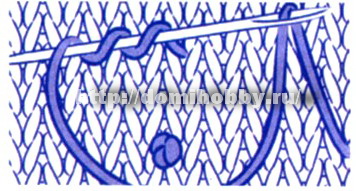
The French small knots are the rounds of thread fixed by the small stitch passing through them.
The quantity of rounds can vary as well as length of the central stitch. If the needle returns to seamy side of cloth at some distance from point of occurrence and has the number of rounds forming dense strip, the received seam is called small knot of rococo.
Carry out needle through knitted cloth and twist thread round needle several times. Then direct needle through opening into which it has been entered. Hold thread hardly tense that rounds have laid down into place, then drag needle through cloth, tightening small knot.
VESTIBULE SEAM
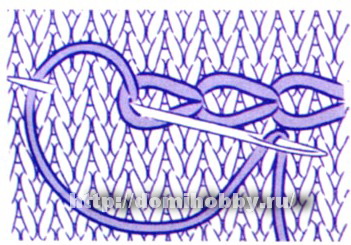
It is series of the loops connected among themselves. The seam can easily change the direction therefore it is ideally suited for twisting lines and filling of forms with color blocks.
Bring needle to upper side of cloth in place of the beginning of seam. Return it to the same opening, having formed loop, and make small stitch needle forward, twist loop round the seemed needle tip.
SEAM LOOP
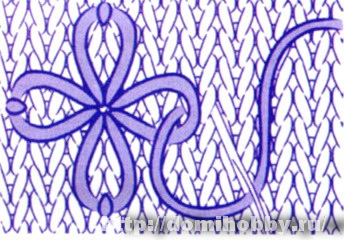
It is series of vestibule stitches, each of which is attached by separately small direct stitch. Bring needle to upper side of cloth in place of the beginning of seam. Return back needle through the same opening, forming loop of the desirable size. Remove needle through cloth back in the most remote point of loop and fix small direct stitch. Repeat necessary number of times.
EMBROIDERY SAMPLES SEAMS OVER THE SEAM BACK THE NEEDLE
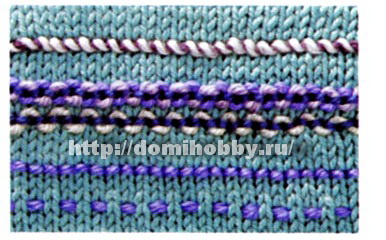
1.The twisted seam - at first is carried out the line by seam needle back then the thread of contrast color is passed under loops from top to down.
2.The wave stitch – thread at first is carried out under seam loop needle from top to down back, and then from below up. It is possible to execute on seam one wavy path or two paths in opposite directions.
3-4. The embroidery seam back needle and seam forward needle can be decorative and in itself.
BEIJING SEAMS
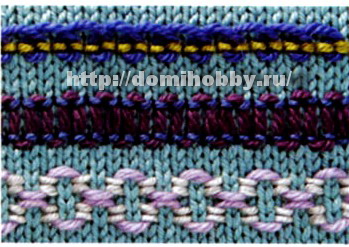
1.On the line of seam back needle the contrast thread is brought with back to upper side under the second loop on the right.
For performance of this seam carry out thread under stitch back
needle to the right from below up and from top to down under the third stitch
to the left.
2.The linked seam back needle and forward needle.
3. The linked seam forward needle is executed over four rows of seams needle by the thread of contrast color laid over two rows, everyone in opposite direction forward.
THE LETTER EMBROIDERED WITH THE BUTTONHOLE STITCH
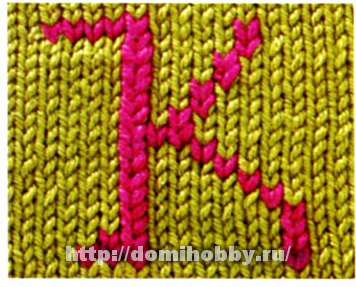
You can choose letters of the most different alphabets but if you use the schemes drawn for embroidery by cross, they need to be extended as height of knitted loop makes only 70% of its width.
EMBROIDERY CROSSES ON ALL CLOTH
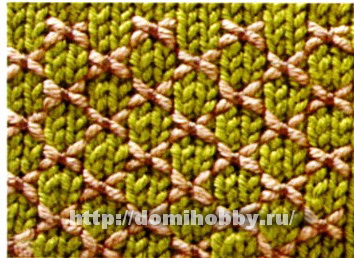
Crosses are located through equal intervals between each row and column and fixed on the center by direct stitch.
EMBROIDERY HA CROSSES TO THE TAPE
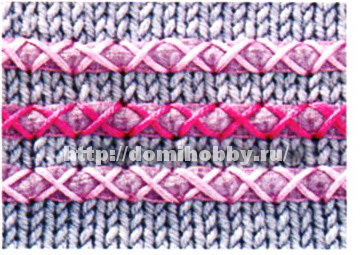
This seam allows to fix in the decorative way tape on knitted cloth.
The tape from organza in two ranks of loops is laid by width across knitted cloth and fixed from above by the seam cross executed by mouline thread thread different shades of pink color.
THE FRENCH SMALL KNOTS
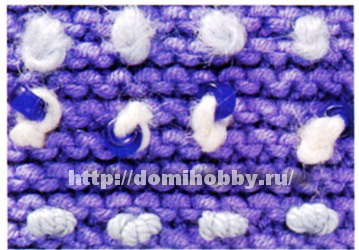
Upper row – the French small knots are executed by two flossy threads.
Average row - before making rounds and to bring thread to seamy side through knitted cloth, on it is strung beads.
The lower row - small knot of rococo: on needle four rounds before the thread has been sent to seamy side are executed.
FRENCH SMALL KNOTS OF BUMP
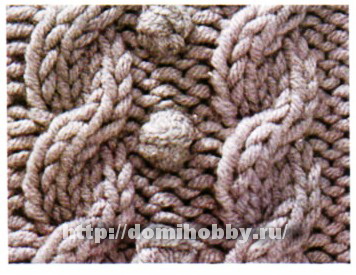
The French small knots which are executed from four locks of core thread are added to plaits. The size of small knots allows to perceive them as part of knitted drawing.
THE FRENCH SMALL KNOTS ON THE ELASTIC BAND
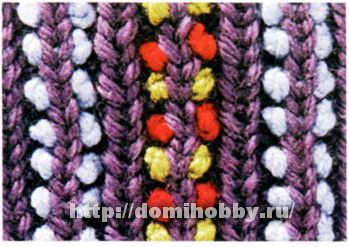
The elastic band 1 x 1 is trimmed by the French small knots of knitted loops in every second row on each side.
COLOR BLOCKS VESTIBULE SEAM
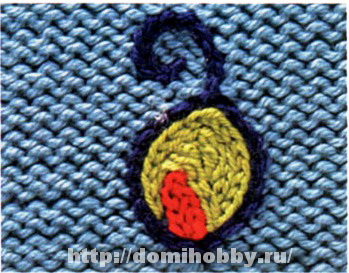
The seam can be carried out in any direction, densely laying stitches on cloth site (attention: elasticity decreases). The sample is executed by hook for knitting and mouline thread threads.
VESTIBULE SEAM OVER DRAWING
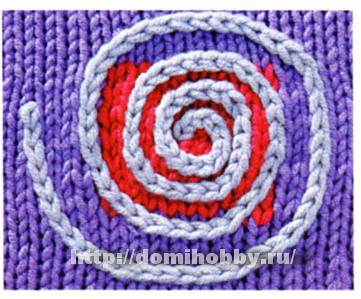
It is possible to draw over knitted pattern. On this sample the square knitted in equipment of intarsia from above is embroidered with spiral pattern hook knitting thread.
PATTERN SEAM OF LOOP
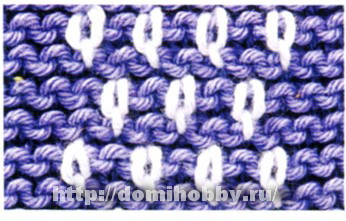
Ranks of stitches are executed in number chess order over three rows of platochny knitting.
FLOWERS FROM LOOPS
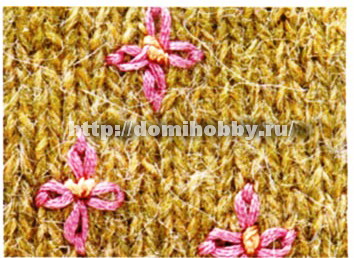
Flowers are embroidered with mouline thread threads. In the center of each flower the yellow small knot of rococo is executed.
DRAWING WITH USE OF DIFFERENT SEAMS
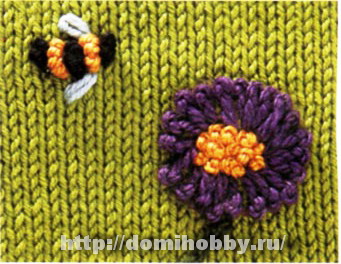
The bee is embroidered with the alternating yellow and brown small knots of rococo which are laid out in a row. Wings are executed by seam loop.
Petals of flower are executed by the extended French small knots (the needle with thread left thread obbivaniye round needle and its return through knitted cloth to 10 mm from that place, from where).
The core of flower consists of yellow French small knots. The stalk is embroidered with vestibule seam.
Continuation: ornamental stitches here.
Material is prepared according to the book Haksell K., Roberts / 1. – Decorative knitting by spokes
-
No comments:
Post a Comment